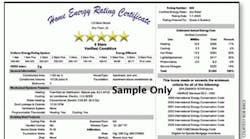A home energy rating is supposed to be a thorough analysis of a home's energy consumption. An HERS (Home Energy Rating System) analysis consists of a review of building plans, multiple onsite inspections, performance testing, and software modeling. A HERS rating can be performed on both new and existing homes and apartment or condo units in multi-family structures of three stories or less.
HERS ratings are used for energy efficient mortgages, energy improvement mortgages, existing home energy audits, and the Environmental Protection Agency's EnergyStar program for certifying energy efficient new home construction.
At the completion of the rating process, an HERS index is assigned. The HERS index is a number, or "score," assigned to a home to quantify its energy efficiency. Since homes come in many different designs and sizes, the HERS index is a comparison of the actual home to a computer modeled "reference home" of similar size and design. The reference home has a HERS index of 100 and is compliant with the 2006 International Energy Conservation Code.
The HERS index is similar to a "miles per gallon" rating for a new vehicle. It's a valuable tool for comparing the energy efficiency of one home to another. For each one point reduction in the HERS index, the home uses one percent less energy than the reference home. So, for example, a home with a HERS index of 90 would be 10% more efficient than the reference home. Likewise, a home with a HERS index of 70 would be 30% more energy efficient than the reference home.
An HERS rating package typically includes energy code compliance documents necessary for attaining a building permit and proving code compliance following construction, a pre-drywall inspection to verify envelope and duct sealing and proper installation of thermal insulation, and a comprehensive report including the HERS certificate, EnergyStar label (if applicable), and EPACT tax credit certificate (if applicable).
The HVAC Controversy
When calculating energy consumption and the HERS Index, the current RESNET standards only consider the rated efficiency of the HVAC equipment (AFUE, SEER, HSPF, COP, EER, and more), and duct leakage to the outside of the thermal boundary, as measured by a duct pressurization test (typically with a duct blaster). However, these are only two of many factors affecting HVAC system performance. In fact, a very poorly performing HVAC system could have both a high equipment efficiency rating and a satisfactory duct blaster test score, and still not be performing to anywhere near its potential.
The discrepancy in design performance to installed performance is directly related to improper equipment setup and improper duct system design, layout, and installation. In the field, we've regularly measured HVAC systems that score incredibly well as part of an HERS rating, yet are only delivering about 60% of their actual capacity. Obviously, measured HVAC performance is a huge gap in the current HERS process.
In order to accurately measure HVAC system performance, a rater must measure delivered BTUH at the equipment, and also at the registers and grilles. This is be done by measuring airflow using a high-quality, calibrated flow hood and/or anemometer; and temperature/enthalpy change using a simple, yet accurate thermometer/hygrometer. With those additional inputs, a well-designed software engine can calculate measured, annualized HVAC system performance. In this way, true HVAC system performance can be accurately accounted for as part of the HERS rating, and problems can be identified and corrected before it's too late. Currently, however, true HVAC performance measurement is not required as part of the HERS standards.
Too Simple for Einstein
One of my favorite quotes from Einstein is, "Everything should be made as simple as possible, but no simpler." It seems, at least up to this point, that we've just cut off the last part of that statement and focused entirely on making things simple. The fact that they're now simpler than they can be in order to actually work is an ominous position to be in. Installing an HVAC system is a lot more complicated than screwing in a compact fluorescent lamp. Sooner or later, people must realize that we do have the technology, the intelligence, and the tenacity to fill in these enormous potholes on the road to energy efficiency.
On the surface, offering residential energy audits to homeowners would seem to be a good business opportunity for HVAC contractors. However, a stumbling block on the road to achieving a true residential energy analysis is that almost all of the "audit" tools and programs out there now (including HERS) require nothing more than a cursory, checklist-style review of HVAC systems, and limited or no testing or verification.
In terms of HVAC performance testing requirements, most current auditing systems, software, and/or procedures typically mandate only that a duct pressurization test be conducted. But when the first step of your only HVAC testing is to be sure that the system is OFF, how much can you possibly hope to gain from your analysis? Typical programs don’t require any temperature measurements, no real airflow measurements under true operating conditions, and no combustion efficiency testing (though they may test for CO safety). This all adds up to produce documents that give a (usually) inaccurate representation of what is truly going on in the home.
These programs have largely been envelope-centered measures (insulation, air sealing, etc.), which have merit and are critical measures for HVAC contractors to understand. However, when the building shell is evaluated independently of installed HVAC system performance, we can often easily recommend minor solutions that won't address the primary concerns, and which will miss the major solutions.
A large body of research spanning 30+ years has been conducted on the proper testing and analysis of HVAC systems and building shells. Unfortunately, most of it's been cherry-picked by program designers, energy professionals, program evaluators, and others, to make it easier to complete more energy audits in less time, with little to no real verification of performance or actual energy savings. I appreciate the desire to create manageable, efficient energy programs. However, as an industry, we can't allow the continued oversimplification of almost everything related to HVAC systems — especially when they are the largest consumer of energy in our homes.
HVAC contractors considering offering home energy audits as an additional business opportunity need to realize that proper and thorough analysis of the heating and cooling systems will only happen with additional, self-imposed testing and verification.
Bob Brice is president of Cenergy, an energy consulting firm in Des Moines, IA. Brice is certified as a home energy rater by the Residential Energy Services Network (RESNET). He has been a presenter and HVAC Comfortech and other industry events. He can be reached at 515/556-1164, or by e-mail at [email protected].









